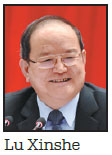Greater Bay Area to bolster Guangxi


Visitors take photos of the cherry blossoms in a scenic spot in Nanning city, South China's Guangxi Zhuang autonomous region, on Feb 21, 2019. [Photo/IC]
The Guangxi Zhuang autonomous region will pick up strong momentum to spur high-quality development from opportunities found through integrating with the neighboring Greater Bay Area, the thriving engine for regional growth, said Lu Xinshe, the region's Party secretary.
"Integration into the Greater Bay Area will facilitate Guangxi's overall development and create mutual benefits for the regions," Lu said.
The overall plan of the Guangdong-Hong Kong-Macao Greater Bay Area, issued last month, aims to develop the city cluster into a thriving global center of technology and innovation and an economic hub.
The Bay Area, home to 70 million people at the end of 2017, had a combined GDP of about $1.5 trillion at that time, surpassing Australia's GDP, according to the World Bank.
As a neighbor, Guangxi already benefited in 2018, attracting 338 billion yuan ($50.4 billion) in investment from the area, Lu said. That included adding many companies, primarily from the electronic information, textile and clothing industries.
Lu said it's time to promote rapid integration with the Greater Bay Area to build further momentum. The Guangxi government has mapped out the integration plan, with a focus on transportation connectivity, industrial collaboration and personnel exchanges.
Guangxi is benefiting from major advances in transportation integration. With the opening of Guangzhou-Shenzhen-Hong Kong Express Rail Link, it now takes 4.5 hours to travel by train from Nanning, Guangxi's capital, to Hong Kong, and cargo ships make the trip between Qinzhou in Guangxi and Hong Kong on a daily basis.
Still, access to the Greater Bay Area needs to be improved, Lu said.
"We must accelerate the construction of high-speed railways, expressways and ports to form a multidimensional transportation system linking Guangxi with the Greater Bay Area," he said.
Guangxi also will lure more emerging industries, advanced manufacturing companies and advanced technologies from the area.
One example is Hezhou, Guangxi, a city that makes good use of technology, according to the regional government.
A Shenzhen-based aircraft technology corporation has invested 2.5 billion yuan in Hezhou for aircraft manufacturing and research in an effort to produce 500 airplanes annually there, according to Xinhua News Agency.
The inflow of tech talent is important as well. Such highly-qualified people play a critical role in the process, and the region is prepared to attract them using preferential policies, Lu said.
Guangxi also is prioritizing the attraction of foreign investment to help build a high-quality economy in a new era of openness, Lu said. The proposed new law on foreign investment is expected to facilitate regional foreign trade.
"We will continue improving our business environment by reducing the tax burden of foreign enterprises and offering more consultation services," said Lu, adding that the government will create fair and equal competition in the market.
As of the end of 2018, the number of foreign enterprises in Guangxi exceeded 5,000, contributing a total investment volume of $62.7 billion.
Guangxi also is using opportunities such as the China-ASEAN Information Harbor Forum and China-ASEAN Expo to draw foreign investment, especially in advanced manufacturing and modern services, to construct a modern industrial system.
"We are determined to make Guangxi a foreign investment hot spot in the new round of opening-up and achieve high-quality economic development." Lu said.
MOST POPULAR
- 1 China to continue opening up its mega-market to world: premier
- 2 Policies concerning expats, foreign enterprises in November 2025
- 3 China to enhance convenience for inbound tourism: minister
- 4 Departure tax refund applications surge 285% as inbound tourism rebounds
- 5 China's foreign trade up 3.6% in first 11 months of 2025







